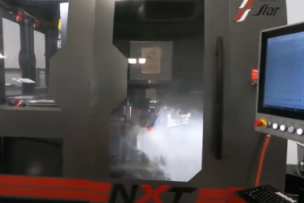“Our Lenox expert stayed there an entire day doing what we call a site survey: We don’t touch anything, we are simply observing what the operator is doing and how the facility is cutting material, just trying to figure out areas for improvement for the customer,” Fernandes says.
“We did a 13-point check where we look at a lot of the various parts on the saw and make sure they are in the best shape possible and don’t need to be replaced,” he says.
“We identified right away that the guides for the band saw blade were installed backward, so we fixed that for them pretty quickly and identified a couple of other parts that were worn down and needed to be replaced, such as the drive wheel and a gearbox,” he adds. “So we got the band saw in very good shape for the customer.”
Proper Blade Maintenance for Industrial Band Saws
Making sure your saw blade is working properly is the best way to reduce downtime, increase production and extend the life of your blade.
Blade failure can happen for many reasons, from poor blade selection to improper cutting speeds and feed rates, or even using a new blade that hasn’t been adequately broken in.
Using the wrong blade for your application is a common issue, Fernandes notes. This was the problem faced by Industrial Overlay: The company was using a blade with a 2-3 tooth pitch, which wasn’t ideal for the cutting they were doing.
When you have more teeth on a blade, you have less space in between those teeth—a portion of the blade called the “gullet” that carries the chips out of the cut as you’re making it. If a gullet is too small, you end up filling it with material too quickly, which means the blade is going to either break or cut crooked, Fernandes notes.
“We noticed that right away their cutting rates were not the best, and we knew we could do better, so we introduced our GEN-TECH blade—a new carbide bandsaw blade—and after getting one cut from their previous blade that would take about two hours, they improved their performance,” Fernandes says.
“Our GEN-TECH blade utilizes WAVE Tech technology that includes a slight pattern on the back edge of the blade body that enables the blade’s teeth to better penetrate the material being cut, and on a hard-to-cut material like Inconel 718, it works really well,” he says.
“We took a two-hour cut to an hour and a half, which was great for the customer, and we extended blade life, so the user didn’t have to replace the blade after one cut. The owner was able to cut between 2,000 to 3,000 square inches per blade, so he was probably getting close to 30 cuts per blade, which is a significant improvement.”
Even though the GEN-TECH blade cost the user about $40 more per blade, he was going through about 160 blades a year and spending around $30,000.
“With the new GEN-TECH blade, based on the performance it is able to achieve, the customer will save about $15,000, so he was going to cut his blade costs in half,” Fernandes notes. “The customer was very happy. We saved him money, which is the end goal, and we met his requirement in terms of blade life, too; and he’s now able to make his cuts a little bit faster.”
The Power of GEN-TECH
Introduced in 2020, the new GEN-TECH carbide-tipped band saw blade for general-purpose cutting provides users with an innovative design and cutting technology. It provides long blade life and a low cost per cut.
Designed for versatility, GEN-TECH cuts a wide variety of materials, shapes and sizes and is ideal for manufacturers in the aerospace, defense and energy sectors, with applications in carbon steels, bearing steels, mold steels, alloy steels, tool steels and stainless, as well as titanium and nickel-based alloys, according to a company news release.
“What makes the GEN-TECH blade work well is that it takes advantage of many successful design features from many of Lenox’s higher-performance carbide products,” Fernandes says. “It uses our best technology from a cutting-edge perspective; over the last few years we’ve utilized a new grade of carbide that’s used in a lot of aerospace applications and has worked very well, and we put that into GEN-TECH. It does very well when you’re cutting materials that are harder to cut, such as stainless steel or in this case Inconel 718.”
To avoid chippage early in the blade’s usage, Lenox hones the tooth edge of the GEN-TECH blade, Fernandes adds.
“So instead of having a very sharp edge, it’s a little bit blunted, so the user doesn’t have to worry about conditioning the blade because it’s already broken in,” he adds. “That limits the amount of chipping on the tooth edge and extends the life of the blade.”
The GEN-TECH blade’s pre-conditioning makes it a very forgiving product, ideal for operators who are less familiar with carbide products, or for saws that are unable to get the full advantages of a multichip carbide product, Fernandes says. Another advantage is the price point: It’s lower than the typical Lenox product, making it much more economical for customers who want to step up from bimetal to carbide.
“Customers used to be scared off by carbide due to its higher price point and their fear of having the blade fail prematurely, but they are interested in the advantages of carbide. With GEN-TECH the user is able to get the best of both worlds,” he says.
What steps are you taking to make sure your band saw operation is as efficient as possible? Share your thoughts and insights in the comments below.




Talk to Us!
Leave a reply
Your email address will not be published. Required fields are marked *